Professional Online: Students from the Department of Applied Foreign Languages serve as art guides at Taipei Fine Arts Museum.


A group of Thai tourists in the Taipei Fine Arts Museum attentively listen to the exhibition works, while the English-speaking, fluent, and professional guides are students from Applied Foreign Languages Department. Every Thursday afternoon, they gather at the Taipei Fine Arts Museum to introduce the exhibition content and works in English. Miss Yu-Cheng Chou and Tsai-Li Lin, both in their third year, mentioned that when foreign visitors stop to listen to their explanations, they feel a bit nervous but also a great sense of achievement.
The Applied Foreign Language Department offers courses "English Guiding" and "Practical English Guiding," where enrolled students serve as guides at the Taipei Fine Arts Museum every Thursday. According to their instructor, Dr. Yung-Wen Yao, before the students begin their roles as art guides, they must first understand the curatorial concept and practice presenting the overall and key artworks on-site 2 to 3 times. After each practice, they make necessary adjustments with the guidance and assistance of Taipei Fine Arts Museum experts, including body language, movement during the tour, and interaction with the audience, especially when explaining to foreign visitors.
Tsai-Li stated that the biggest challenge in conducting art tours in English is "thoroughly understanding the meaning behind each work" and "transforming English-specific terminology into easy-to-understand language." Yu-Cheng also believes that making the works more vivid is an important task for guides. Guiding is not just about reciting a script; eye contact, body language, and interaction with the audience while explaining the works make the tour more interesting and not dull. Especially when dealing with challenging academic English vocabulary, they need to appropriately convert it into understandable words. "Receiving encouragement and feedback from the audience boosts our confidence," they added."
The Applied Foreign Language Department stated that by combining the course with museum tour explanations, they aim to have students step out of the classroom and enhance their English-speaking abilities and confidence in public settings. In the vast exhibition space, they explore domestic and international history and contemporary art history through artworks, engage in international issues, and improve critical thinking skills.
瀏覽數:
